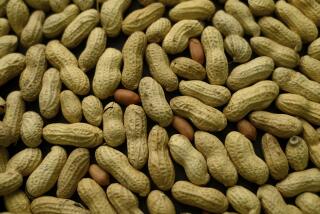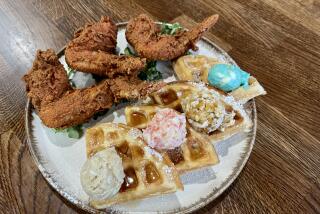Peanut Butter Turns 100; Creator Still Unknown : Food: It is the ideal family concoction--cheap, filling and nutritious, despite the high fat content.
- Share via
ST. LOUIS — It’s official: Peanut butter now has been sticking to the roofs of our mouths for a century.
Chunky or creamy, eaten plain or with jelly, bananas, mayonnaise or marshmallows, peanut butter has stood the test of time.
Lst monthh, peanut butter enthusiasts celebrated the 100th anniversary of the creation of the ideal family food--cheap, filling and nutritious, despite the high fat content--that celebrities also love.
For starters, there is Elvis Presley. His favorite sandwich was peanut butter and bananas, grilled in butter. According to biographer Albert Goldman, Presley and his cronies once flew to Colorado just to pick up a batch of gourmet peanut butter sandwiches.
Tennis player Chris Evert is said to eat peanut butter on whole-grain bread as a last-minute snack before matches. Conservative columnist George Will says he eats a peanut butter-and-sweet-pickle sandwich, a family tradition, twice a week.
Former President Gerald R. Ford is among the 50,000 members of the Adult Peanut Butter Lovers Fan Club, and retired Sen. Barry Goldwater (R-Ariz.) once used peanut butter for shaving cream on a camping trip.
Peanut butter, in short, is an American classic--and a $1-billion industry.
Still, its origins remain something of a mystery.
The Atlanta-based Peanut Advisory Board knows that a St. Louis doctor is responsible for peanut butter’s debut in March, 1890, and that patents for peanut grinding machines were issued several years later. But it does not have a name for the man who first ground peanuts into paste and spread them on a slice of bread.
“Nobody thought it was a big deal back then,” said Suzanne Corbett, a culinary historian in St. Louis who says she is close to solving the case. “They decided it was great-tasting and cheap, but the emphasis was on commercialism, not invention.”
According to the Peanut Advisory Board, the St. Louis doctor created peanut butter as a nutritious protein substitute for elderly patients whose teeth were so poor that they could not eat meat.
The doctor, who made his peanut butter with a kitchen hand-grinder, then went for mass marketing. George A. Bayle Jr., owner of a food products company, packaged and sold the spread, for 6 cents a pound.
Bayle peanut butter cans from 1910 and later bear the inscription: “A sandwich a day keeps your children at play.”
Since December, Corbett has been poring over the Bayle company files, which are scattered over the St. Louis area, and has been in contact with a woman in her 70s who worked for the firm.
She has narrowed the possibilities down to four men and is working on the supposition that the inventor of peanut butter worked for a sanitarium near Bayle’s factory.
“It’s sort of like peeling wallpaper off an old room,” Corbett said. “You keep going down and down and down.”
Corbett is certain the credit should not go to Dr. John Harvey Kellogg of Battle Creek, Mich., a surgeon who patented the first peanut butter grinder. Kellogg was making peanut butter at about the same time as the St. Louis physician in a search for a vegetarian food for patients at his sanitarium.
According to Kellogg Co. archives, Kellogg and his brother, W. K. Kellogg--famous for his cereal company--bought 10 pounds of peanuts, roasted them in an oven, put the nuts in a pillow case to remove the hulls, weeded out the husks and then put the remaining material through grain rollers to make peanut butter.
W. K. Kellogg, the business manager of the sanitarium, opened Sanitas Nut Co. and supplied foods like peanut butter to the sanitarium and local groceries. But, after a while, John Kellogg changed the formula and decided to steam the peanuts instead.
“It tasted terrible,” Corbett said. “So they said: ‘To heck with that, let’s concentrate on cereal.’ ”
Peanut butter was a big seller at the 1904 World’s Fair in St. Louis but did not really take off until much later. In the 1920s, the process of stabilization was discovered, allowing it to be stored without refrigeration.
The biggest boost may have occurred in World War II. The government fed peanut butter to GIs, who then came home, started the baby boom and fed the stuff to their kids.
Peanut butter was a regional industry until 1955, when Procter & Gamble Co. bought Big Top peanut butter and reintroduced it as Jif, now the No. 1 seller, and Best Foods bought Skippy.
More peanut facts:
* Peanuts, primarily grown in eight Southern states, are the nation’s 12th largest cash crop. They are a $500-million-a-year crop in Georgia, which produces nearly half of the nation’s supply.
* It takes 548 peanuts to make a 12-ounce jar of peanut butter, and an acre of peanuts will yield 30,000 peanut butter sandwiches.
* About half of the 4-billion-pound annual crop is devoted to the production of peanut butter and the other half is almost equally split among salted nuts, candy and peanut oil.
* Ninety percent of a jar of peanut butter must be peanuts, but it also may contain salt, sweeteners and hydrogenated vegetable oil as a stabilizer.
* George Washington Carver discovered that the peanut plant could also be used in shaving cream, ink, paint, explosives, shampoo, pet litter, fire logs, lipstick and soap.
* Americans are expected to eat 800 million pounds of peanut butter this year, more than double the 350 million pounds consumed in 1960, according to the peanut board. That’s an average of 3.3 pounds per person.
* Although peanut butter is portrayed as a kids’ food, adults consume 55% of it.
Not everyone loves peanut butter, of course. In fact, there is even a word for the phobia of getting peanut butter stuck to the roof of the mouth: arachibrityraphobia.
The search for peanut butter’s inventor continues. Coming up with a name may not mean much for sales, but Corbett is convinced that it is important research.
“Food history is something we can all relate to,” Corbett said. “Food transports one back in time. Combine the smells and the taste, and it’s an instant flashback.”
More to Read
Eat your way across L.A.
Get our weekly Tasting Notes newsletter for reviews, news and more.
You may occasionally receive promotional content from the Los Angeles Times.










